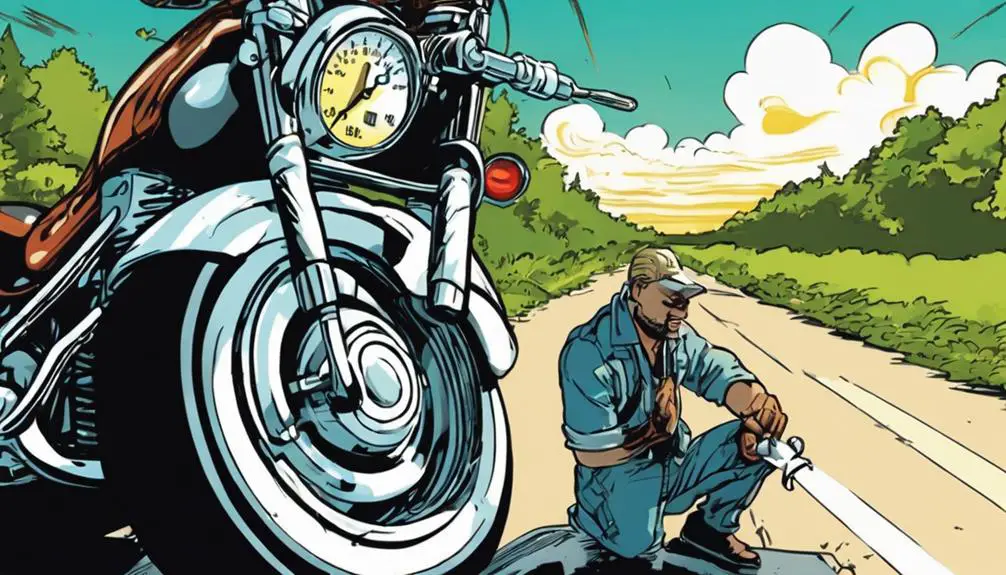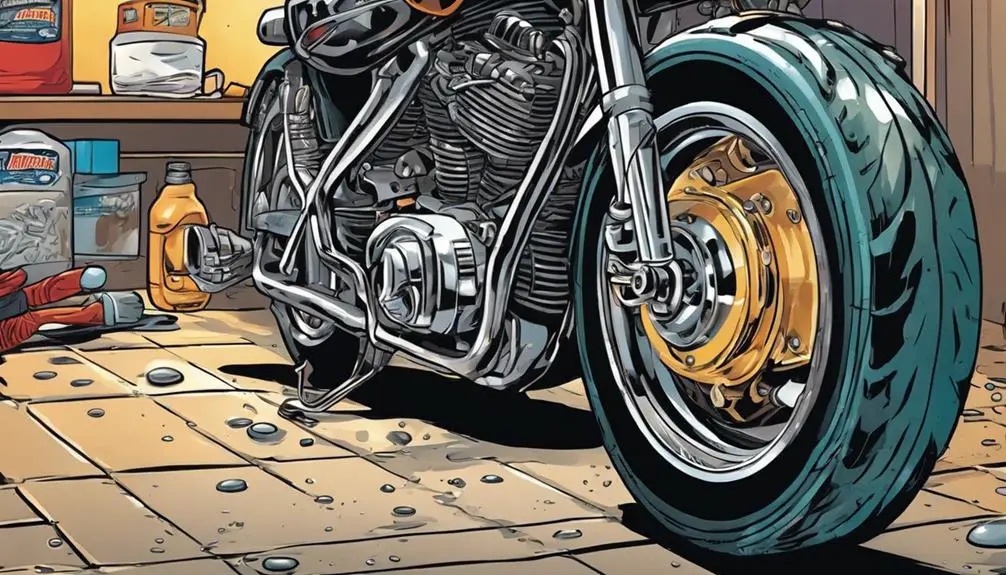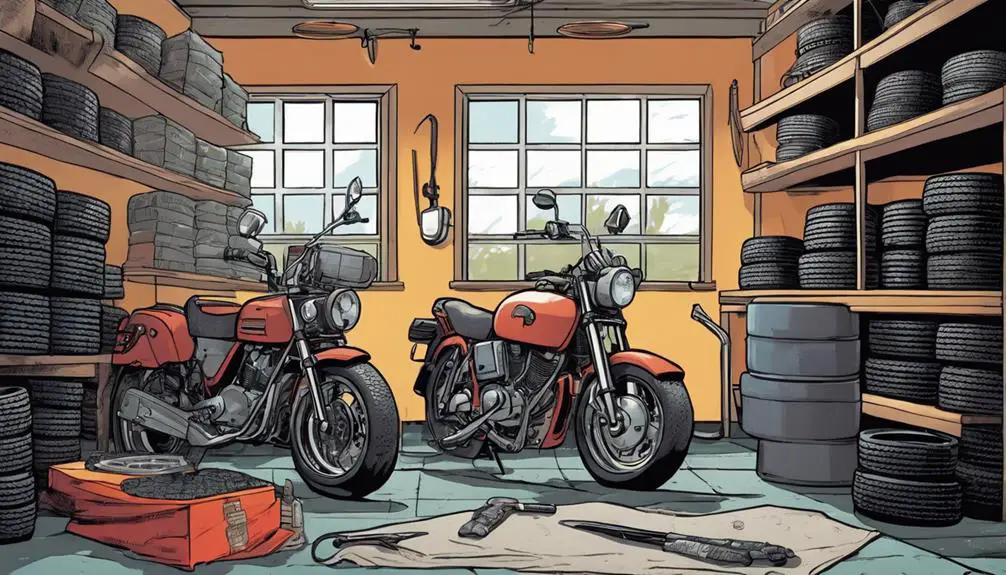Did you know that nearly 30% of motorcycle accidents are linked to tire issues? To guarantee you're not part of that statistic, it's vital to prioritize tire care. By maintaining proper tire pressure, inspecting tread depth, and following a few other essential practices, you can greatly enhance your safety and performance on the road. Curious about the specific tips that can keep your tires in top shape? Let's explore how you can effectively extend their lifespan and improve your riding experience.
Key Takeaways
- Check tire pressure monthly and before long rides, ensuring accurate readings when tires are cold.
- Inspect tread depth regularly using the penny test; replace tires if Lincoln's head is visible.
- Clean tires and rims with motorcycle-specific cleaners and a soft brush to enhance lifespan.
- Rotate tires every 5,000 to 7,000 miles to promote even wear and maintain handling.
Check Tire Pressure Regularly

Check your motorcycle's tire pressure regularly to guarantee peak performance and safety on the road. Keeping your tires properly inflated is essential for achieving that liberating ride you crave. Low tire pressure can lead to poor handling, reduced fuel efficiency, and even tire blowouts, which can turn your freedom into a nightmare.
You'll want to check your tire pressure at least once a month and before long rides. Invest in a good-quality tire pressure gauge; it's a small tool that pays off big in maintaining your motorcycle's health.
Remember that tire pressure often varies with temperature changes, so check it when your tires are cold for the most accurate reading. If you find your tires under-inflated, don't hesitate to top them off with air. Most gas stations have air pumps that make it easy.
Keep in mind that over-inflation is just as dangerous, so always refer to your owner's manual for the recommended pressure. By staying on top of your tire pressure, you're not just ensuring a safe ride—you're embracing the freedom and exhilaration of the open road. You deserve that adventure!
Inspect Tread Depth
Maintaining proper tire pressure is just the first step; regularly inspecting tread depth is equally important for ensuring ideal traction and safety on your motorcycle. A well-maintained tread depth gives you the grip needed to conquer any road and embrace the thrill of the ride.
To check tread depth, use the penny test: insert a penny into the tread with Lincoln's head facing down. If you can see the top of his head, it's time for new tires. Ideally, you want at least 2/32 of an inch of tread for safe riding, especially in wet conditions.
Keep an eye out for uneven wear patterns, as they can signal alignment issues or improper inflation. If you notice any bald spots or significant wear, take immediate action. Remember, tires are your only contact with the road, so don't underestimate their importance in your freedom to ride.
Clean Tires and Rims

Keeping your tires and rims clean not only enhances their appearance but also helps extend their lifespan and improve performance. A clean ride isn't just about aesthetics; it's about ensuring you have the grip and control you crave on the open road.
Here's how you can maintain those essential components:
- Use the Right Cleaner: Avoid harsh chemicals that can damage rubber and metal. Opt for motorcycle-specific cleaners.
- Brush Gently: Use a soft brush to remove dirt and grime without scratching the surface. Be thorough but gentle.
- Rinse Thoroughly: After cleaning, rinse off all soap and residue. Any leftover cleaner can degrade the tire material over time.
Rotate Tires Appropriately
Regularly rotating your motorcycle tires helps guarantee even wear, which can considerably enhance your bike's handling and longevity. It's a simple yet powerful way to maintain that sense of freedom you crave on the open road. By switching the front and rear tires, you promote balanced wear, ensuring both tires grip the road effectively.
Aim to rotate your tires every 5,000 to 7,000 miles, or sooner if you notice uneven wear. Check your owner's manual for specific recommendations tailored to your bike. When you do it, make sure to inspect the tread depth and look for any signs of damage or punctures. This proactive approach keeps your ride smooth and safe.
Don't forget to maintain proper tire pressure as you rotate. Under-inflated or over-inflated tires can compromise handling and performance, and we all know that feeling when the bike doesn't respond as it should.
Store Tires Correctly

Proper tire storage is just as important as rotation, ensuring your motorcycle tires stay in top condition when you're not on the road.
Whether you're taking a break during the off-season or just parking your bike for a while, how you store your tires can make a significant difference.
Here are some key tips to keep your tires ready for your next adventure:
- Keep them clean: Wash off dirt and debris to prevent damage.
- Store upright: Position tires vertically to avoid flat spots.
- Use a cool, dry place: Temperature extremes and moisture can deteriorate rubber.
Frequently Asked Questions
How Often Should I Replace My Motorcycle Tires?
You should replace your motorcycle tires every 5,000 to 10,000 miles, but it really depends on your riding style and conditions.
If you notice cracks, bulges, or uneven wear, it's time for a change, regardless of mileage.
Regularly checking your tires keeps you safe and lets you ride freely.
Trust your instincts; if something feels off, don't hesitate to swap them out for a smoother, more liberating experience on the road.
What Signs Indicate a Tire Needs Immediate Replacement?
When you're checking your motorcycle tires, look for signs that scream “replace me!”
Deep cracks, bulges, or exposed cords indicate serious issues. If tread wear is uneven or the depth is less than 1/16 of an inch, it's time to act.
Also, if you feel vibrations or notice handling changes, don't ignore them. Your safety's at stake, so trust your instincts and replace those tires when they show these warning signs.
Can Different Tire Brands Be Mixed on One Motorcycle?
Imagine cruising down an open road, the wind in your hair, feeling the freedom of the ride.
Mixing tire brands on your motorcycle isn't recommended. Different brands can have varying grip levels and wear patterns, potentially compromising your safety and handling.
To keep that liberating experience smooth, it's best to stick with the same brand and model for both tires. Your ride deserves consistency and reliability, so don't take unnecessary risks.
How Does Riding Style Affect Tire Wear?
Your riding style plays a huge role in tire wear. If you ride aggressively, with hard acceleration and sharp turns, you'll wear your tires down much faster.
On the other hand, a smoother, more relaxed style can extend their lifespan. The way you brake also matters; sudden stops can cause uneven wear.
Are There Specific Tires for Different Weather Conditions?
When the rubber meets the road, it's essential to choose the right tires for the weather.
You've got options: all-season tires work well in mild conditions, while dedicated wet-weather tires grip better in rain.
For winter riding, snow tires provide extra traction.
Don't forget, the right tire can make your ride safer and more enjoyable, so invest wisely.
Conclusion
By following these tire care tips, you'll keep your motorcycle running smoothly and safely.
Remember, a little maintenance goes a long way, so don't wait until the rubber meets the road to take action.
Regularly checking tire pressure, inspecting tread depth, and keeping everything clean will help you avoid unnecessary problems down the line.
So, roll up your sleeves and give your tires the attention they deserve—it's a small price to pay for peace of mind on the open road!